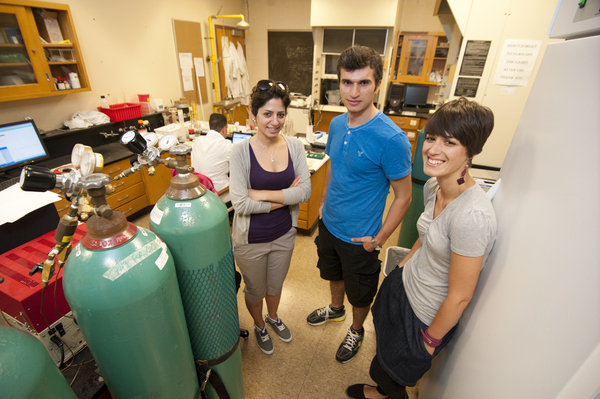A green, inexpensive solution to groundwater contamination

Trichloroethylene—a degreasing agent frequently used for military and industrial applications—has seeped into groundwater around the world, with serious health consequences. Scientists have thus far had little success in reducing the widespread contamination of trichloroethylene through bioremediation, chemical reduction, and oxidation. But now three Northeastern researchers—members of one of Northeastern’s federally-funded research centers—are developing an electrochemical technique has the potential to address the problem.
Postdoctoral researcher Lily Rajic and doctoral candidates Noushin Fallahpour and Ali Ciblak work in Northeastern’s PROTECT Center, a research collaboration between the College of Engineering, Bouvé College of Health Sciences, the University of Michigan, and the University of Puerto Rico. Funded by the National Institute for Environmental Health Sciences, PROTECT brings together experts in engineering, public health, and biomedical and environmental sciences to study the relationship between exposure to environmental contamination and preterm birth. The center focuses on Puerto Rico, as the U.S. territory is disproportionately impacted by a preterm birth rate one-and-a-half times that of the overall U.S. and an extensive legacy of contamination.
Rajic, Fallahpour, and Ciblak are developing a solar-powered device that uses direct current to spark a chemical reaction that will transform trichloroethylene into an inactive substance. What differentiates this concept from competitors are the minimal power requirements and cheap materials; these enable the device to be placed in remote locations at little expense.
“It’s important that our solution is low-cost and can run off the grid, given the number of contaminated sites and the widespread nature of the problem,” Rajic said.
The breadth of groundwater contamination means that the system must be simple and self-sustaining, according to Fallahpour. “The work is not going to make much of an impact if what we develop is something that everyday people won’t be able to use,” Fallahpour said.
The research team has presented its work at several conferences this year, including the PROTECT-hosted International Symposium on Electrokinetic Remediation and the Symposium on Water Innovation in Massachusetts, both held at Northeastern last month. The conferences served as an opportunity for the researchers to get critical feedback on their project from industry and academic experts and develop partnerships once their work moves from the laboratory to the field for testing.
“We’re making a lot of progress on our methods and design and we’re getting very excited about moving our work out into the field as soon as possible,” Rajic said. “This is important work, and I really believe we have a solution that can make a difference.”





